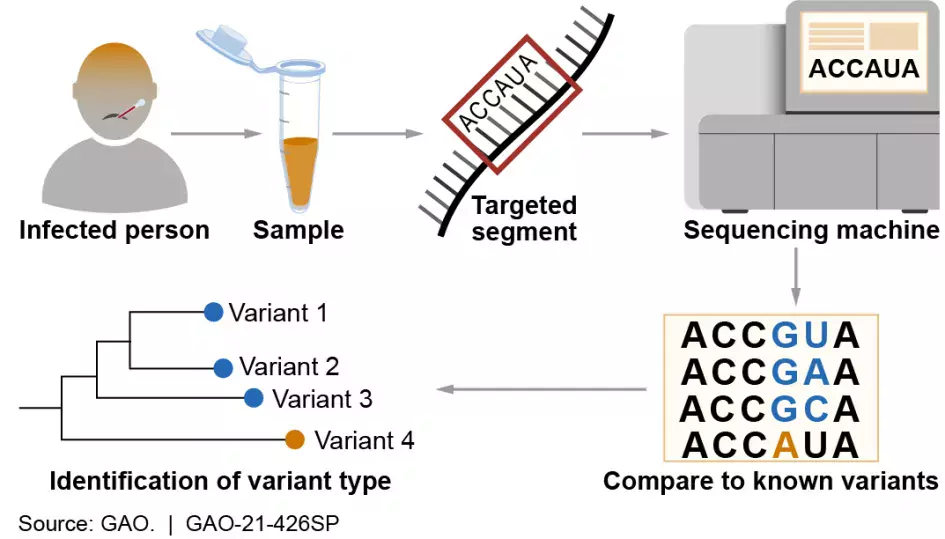Gene Sequencing Can Track COVID Variants, But High Costs and Security and Privacy Concerns Present Challenges
As variants of the virus that cause COVID-19 emerge, researchers are using newer technologies to quickly detect them and track their transmission. However, the high cost of the technology may be prohibitive, and security and privacy concerns present other challenges.
Today’s WatchBlog post explores these technologies and their challenges.
Image

What is gene sequencing?
Genomic sequencing—or gene sequencing when referring to a single gene—can decode a pathogen’s genetic material, either DNA or RNA. Sequencing can identify the order of chemical “letters” of its genes.
Each letter of genetic code represents a chemical unit called a base. A sequence of bases can reveal useful information for identifying and tracking diseases. For example, sequencing of SARS-CoV-2, the virus that causes COVID-19, is used to track the spread of variants (see figure below).
Use of Genomic Sequencing in the Identification of Infectious Pathogen Variants
Image

How are new technologies changing things?
Newer technologies, such as next generation sequencing, can read much longer strings of letters from samples than earlier methods.
For example, one sequencing technology repeatedly copies, tags, sorts, and reads genetic code. While earlier versions could do this, too, what makes this technology unique is that it works in parallel on different parts of the genome at the same time, thereby speeding up the process.
What opportunities does genomic sequencing present?
Genomic sequencing could help identify new pathogen variants shortly after they appear, generate more data to estimate the prevalence of variants in populations, and lead to the development of targeted treatments.
Analyzing data from a large number of pathogens using next generation sequencing can also help identify vaccine candidates and ensure that they are effective against common and emergent pathogen variants. For example, this technology was used in the development of the current COVID-19 vaccines.
Development of smaller, mobile, and more affordable sequencing technology may make these technologies available in more communities and help us respond to future virus outbreaks faster.
What about the challenges?
Up-front costs are among the challenges that limit the use of genomic sequencing technologies. Purchasing laboratory equipment, computer resources, and staff training requires significant up-front investments. However, the cost per sequence is far less today than it was under earlier methods.
This technology has also raised concerns about privacy. For example, genomic data could be used to identify people who may have been infected with, or transmitted, new and deadly pathogen variants. If that information were to be made public, those who test positive might be discriminated against or stigmatized.
Increased access to sequencing technologies could also raise security concerns because state or non-state actors could use it with gene editing technology to effectively modify pathogens as part of a biological warfare effort.
To learn more about how next generation sequencing works and what its challenges are, check out our new Science & Tech Spotlight.
- Comments on GAO’s WatchBlog? Contact blog@gao.gov.
GAO Contacts
Related Products

GAO's mission is to provide Congress with fact-based, nonpartisan information that can help improve federal government performance and ensure accountability for the benefit of the American people. GAO launched its WatchBlog in January, 2014, as part of its continuing effort to reach its audiences—Congress and the American people—where they are currently looking for information.
The blog format allows GAO to provide a little more context about its work than it can offer on its other social media platforms. Posts will tie GAO work to current events and the news; show how GAO’s work is affecting agencies or legislation; highlight reports, testimonies, and issue areas where GAO does work; and provide information about GAO itself, among other things.
Please send any feedback on GAO's WatchBlog to blog@gao.gov.




